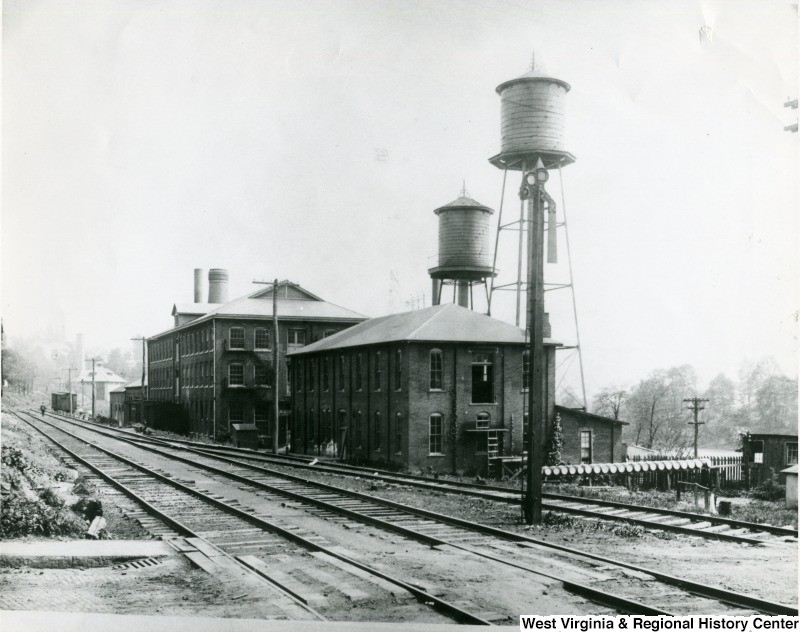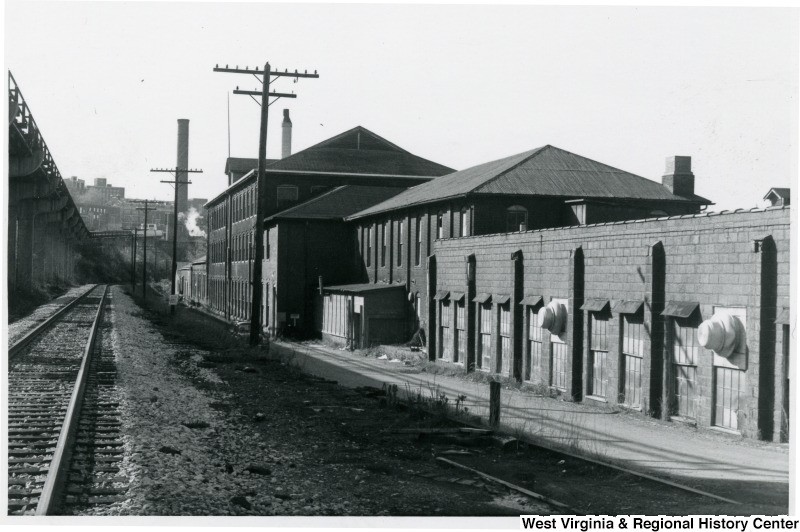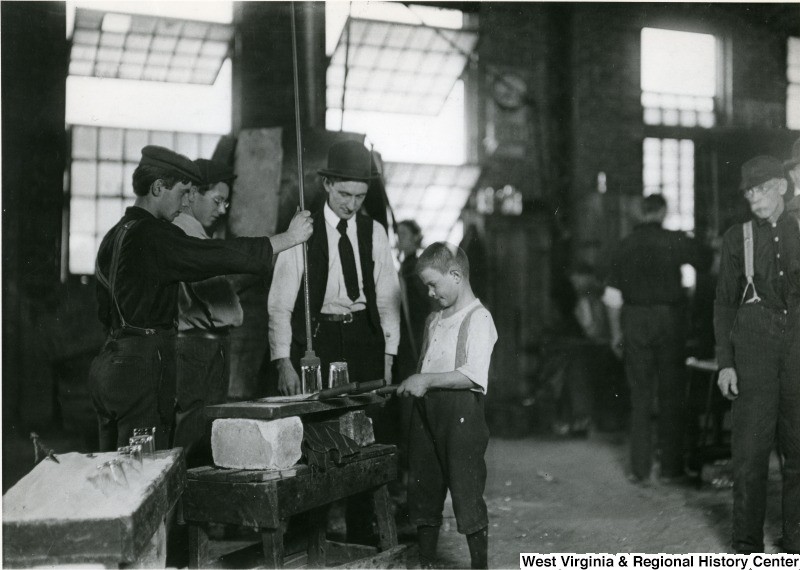Beaumont Glass Factory (Union Stopper Glass Factory)
Introduction
Text-to-speech Audio
Images
One of the few pictures of the original Monongahela Textile Company building, likely taken shortly after it was acquired by the Union Stopper Company. Courtesy of the West Virginia and Regional History Center, WVU Libraries.

View of the east side of building along the railroad (now the Rail Trail) looking south. This image from the late 1980s depicts the original textile building as well as some additions. West Virginia and Regional History Center, WVU Libraries.

Lewis Hine photograph from 1908 of a child working in the Union Stopper Company factory. West Virginia and Regional History Center, WVU Libraries, and Library of Congress.

Backstory and Context
Text-to-speech Audio
After the Monongahela Textile Company building was handed over to the bank in 1903, it sat empty and abandoned for two years until the Union Stopper Company came to Morgantown. On March 8, 1905, the Union Stopper Company bought the land and buildings for $17,500 from the Bank of the Monongahela Valley.[1] As the name would suggest, the Union Stopper Company made stoppers for non-refillable glass bottles and did well for itself.
One of the employees at the plant, Charles N. Brisco, filed for a patent not six months after the company acquired the old Textile Mill building which he received confirmation of on March 6, 1906. In the long and complicated application, Brisco explained that his patented stopper was an improvement on previous stoppers because of a spring loaded top that was released by the pressure of the liquid inside, allowing the bottle’s contents to pour out, but it did not allow the bottle to be refilled.[2] How many of Brisco’s patented stoppers were made, or if it was even adopted by his company, is not clear, but the stopper company itself was an important name in the glassmaking industry and Brisco’s patent may have gone on to be truly innovative in the business.
In 1906, the Union Stopper Company hired a new manager in the form of Percy J. Beaumont. Beaumont was an Englishman whose glassmaking career began when he immigrated to the United States in 1882 with his sister, who married Harry Northwood of the Northwood Glass Company in Kingswinford, England.[3] Northwood trained Percy Beaumont and by 1890, Percy opened his own glassblowing company in Martins Ferry, Ohio which moved to Grafton, West Virginia in 1902. By 1906, Percy had been offered the job at the Union Stopper Company, accepted the job. Near the same time, in 1908, the National Child Labor Committee hired Lewis W. Hine to investigate and photograph child labor conditions throughout the country. That same year, Hine visited the Union Stopper Company where he took a number of pictures of the conditions inside the plant.[4] In 1913, Percy was reporting over $150,000 in annual profit and the company employed 175 people – fifty percent men, thirty percent boys, and twenty percent girls, and with over forty percent of the total workforce being “skilled.”[5] By 1918, the company’s name had changed to Beaumont Glass Company. According to sources describing the glass making industry in the 1920s through the 1960s, the Beaumont Company “was known for its light shades, inkwells, and light globes,” producing glass throughout the Great Depression and becoming one of the county’s premier glass lighting and light-fixture manufacturers. Percy died in 1947, leaving the Beaumont Company to his grandson, Arthur B. Beaumont who served as manager until 1962.[6]
The company remained in Beaumont hands until 1988 when it was bought by Michael Carlow who also owned the L. E. Smith Glass Company of Mt. Pleasant, Pennsylvania. Carlow was accused of running a check-kiting scheme in the early 1990s and by 1996 was convicted and sentenced to six years in prison.[7] While the Smith Glass Company is still producing glass today, Beaumont was not so fortunate as it was forced to close its doors in 1991 because it could not pay any of its loans, in part, no doubt, because it was one of the many victims of Carlow’s check-kiting scheme. President of the Beaumont Company, Henry Clew, defaulted on a $355,000 promissory note grated to the company by the One Valley Bank of Morgantown. On June 30, 1994, the Beaumont Company building and all its contents were sold to SME Industries, today a steel contracting firm, for $625,000. Four days later, SME sold the property to Frank V. Carlow Irrevocable Trust for the price they had paid for it just a few days before, who sold the property again one year later for just $10.00.[8]
One explanation for the property changing hands so many times is contamination of the soil from the chemicals and harmful substances used in the glassmaking process at the site. In 1989, the Northern West Virginia Brownfields Assistance Center conducted testing on the soil along the river and found no significant amounts of harmful chemicals except in the soil underneath the “Etching Room” at the Beaumont factory. The Beaumont Company began remediation work and found large amounts of lead and twelve drums worth of hazardous material that had to be removed. By 1991, the cullet pile, refuse glass that is too small to be recycled, and the “Etching Room” had become serious environmental and conservation concerns, bringing pressure from the EPA and other organizations. In 1996, the EPA conducted more testing and, rather than try and save the building and its contents, settled for demolition of the main building which was carried out in 1998.
The only remaining buildings of the Beaumont Glass Factory are what comprise the Surplus City store today. The nearby land was considered one location for a recreational park, though tests showed high levels of arsenic, antimony, cadmium, lead, and “polynuclear aromatic hydrocarbons,” all of which tested in such high levels that remediation costs soared above $200,000.[9]
After demolition and years of testing, much of the original Monongahela Textile Company and Beaumont Glass Factory property sits bare. While some of Morgantown’s investment companies and university students have tried to create a unique and community friendly way to use the waterfront property, all proposals have come up empty-handed.
Sources
[1] Monongalia County Courthouse Records, Deed Book 82, page 466-67; and “The Fabulous Monster: Owens Bottle Machine,” Corning Museum of Glass, www.cmog.org/article/fabulous-monster-owens-bottle-machine, accessed April 26, 2016.
[2] Charles N. Brisco, “United States Patent: 814352 A – Stopper, March 6, 1906. http://www.google.com/patents/US814352.
[3] Beaumont Glass Company Bio, Glass Lovers Glass Database, http://estatesalestore.com/gallery2/main.php?g2_itemId=1817.
[4] Barbara Orbach Natanson, Introduction – National Child Labor Committee Collection, Web, /www.loc.gov/pictures/collection/nclc/background.html?loclr=flik, accessed April 8, 2016.
[5] Ray V. Hennen, David B. Reger, and I. C. White, “Union Stopper Company,” in West Virignia Geological Survey: Marion Monongalia, and Taylor Counties (Wheeling, W.V.: Wheeling News Litho. Co., 1913), 20-21.
[6] “Percy John Beaumont,” Find-A-Grave Database, http://www.findagrave.com/cgi-bin/fg.cgi?page=gr&GSln=Beaumont&GSiman=1&GScid=1646496&GRid=141287759&.
[7] Len Boselovic, “Pittsburgh White-Collar Criminal Michael Carlow Sentenced,” Pittsburgh Post-Gazette, November 15, 2013. http://www.post-gazette.com/business/2013/11/15/Pittsburgh-white-collar-criminal-Michael-Carlow-sentenced/stories/201311150191. Carlow was convicted again in 2013 for tax evasion and was sentenced to another thirty-five months in prison.
[8] Monongalia County Courthouse Records, Deed Book 1093, page 594-598; Monongalia County Courthouse Records, Deed Book 1101, page 632; Monongalia County Courthouse, Deed Book 1133, page 674. Aside from Carlow’s check-kitting, the employees of Beaumont Glass went on strike in 1991, most likely due to wages owed to them by Clew.
[9] M. Jualiana Lloreda, “Beaumont Glass Morgantown West Virginia: Sustainable Urban Redevelopment through Interpretive Design, Brownfield Reclamation, and Mixed Uses,” (Master’s Thesis, West Virginia University, 2013), 34-40. https://issuu.com/mjulianalloreda/docs/beaumont_glass_factory_-_mla_thesis.
Images:
"Glass Factory." Photo. West Virginia and Regional History Center, WVU Libraries. Accessed January 2018. http://wvhistoryonview.org/catalog/wvulibraries:14117
"Beaumont Glass Company, Morgantown, W.Va." Photo. Circa 1980s. West Virginia and Regional History Center, WVU Libraries. Accessed January 2018. http://wvhistoryonview.org/catalog/wvulibraries:11269
"Young Apprentice at the Union Stopper Company, Morgantown, W. Va." Photo. Lewis Hine. 1908. West Virginia and Regional History Center, WVU Libraries. Accessed January 2018. http://wvhistoryonview.org/catalog/wvulibraries:21158
Researched compiled by Bobby Novak. Edited by Elizabeth Satterfield and Pamela Curtin.
